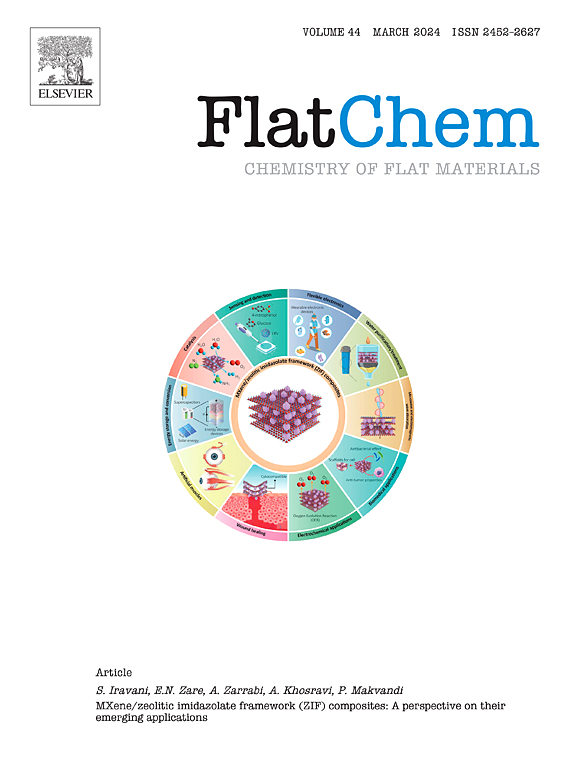Ag3和Au3簇修饰的HfS2表面吸附LIBs热失控气体的DFT研究
IF 6.2
3区 材料科学
Q2 CHEMISTRY, PHYSICAL
引用次数: 0
摘要
本文采用密度泛函理论(DFT)方法研究了装饰在HfS2表面的Ag3和Au3簇对锂离子电池热失控气体(C2H4、CH4和CO)的吸附性能。采用PBE泛函数、广义梯度逼近法(GGA)和投影增广平面波法(PAW)进行计算,并采用DFT-D3法对范德华力进行校正。发现当Ag3和Au3位于Hf原子正上方时,结合能最大,结构稳定。纯HfS2对C2H4的吸附性能最好。Ag3@HfS2和Au3@HfS2对C2H4和CO的吸附性能有所提高,对CH4的吸附性能较差。C2H4在Au3@HfS2上的吸附强于Ag3@HfS2, CO在Au3@HfS2上的吸附为化学吸附。CH4的吸附对体系的电子结构影响不大,而C2H4和CO的吸附具有显著的电子相互作用。吸附气体降低了Ag3@HfS2和Au3@HfS2的功函数,C2H4失去的电子最多。Ag3@HfS2的吸附性能受双轴应变的调节,当应变为−8%时吸附能最大。Ag3@HfS2的吸附不稳定。Au3@HfS2在室温下可作为CO和C2H4的清除剂,有望用于锂离子电池高温下热失控气体的监测。本研究为锂离子电池热失控气体检测提供了理论依据。本文章由计算机程序翻译,如有差异,请以英文原文为准。

A DFT study of adsorption of LIBs thermal runaway gases by HfS2 surface decorated with Ag3 and Au3 cluster
In this study, the adsorption properties of Ag3 and Au3 clusters decorated HfS2 surfaces for thermal runaway gases (C2H4, CH4 and CO) of lithium ion batteries (LIBs) were investigated by density functional theory (DFT) method. The Perdew-Burke-Ernzerhof (PBE) functional, the generalized gradient approximation (GGA) and the projection augmented plane wave (PAW) method are used in the calculation, and the van der Waals force is corrected by the DFT-D3 method. It is found that when Ag3 and Au3 are located directly above Hf atoms, the binding energy is the largest, and the structure is stable. The pure HfS2 has the best adsorption performance for C2H4. The adsorption performance of Ag3@HfS2 and Au3@HfS2 for C2H4 and CO is improved, and the adsorption performance for CH4 is poor. The adsorption of C2H4 on Au3@HfS2 is stronger than that of Ag3@HfS2, and the adsorption of CO on Au3@HfS2 is chemical adsorption. CH4 adsorption has little effect on the electronic structure of the system, and C2H4 and CO adsorption have significant electronic interaction. The adsorbed gas reduces the work functions of Ag3@HfS2 and Au3@HfS2, and C2H4 loses the most electrons. The adsorption performance of Ag3@HfS2 can be regulated by biaxial strain, and the adsorption energy is the largest when the strain is −8 %. The adsorption of Ag3@HfS2 is unstable. Au3@HfS2 can be used as a CO and C2H4 scavenger at room temperature, and it is expected to be used to monitor the thermal runaway gas of lithium ion batteries at high temperature. This study provides a theoretical basis for thermal runaway gas detection of lithium-ion batteries.
求助全文
通过发布文献求助,成功后即可免费获取论文全文。
去求助
来源期刊

FlatChem
Multiple-
CiteScore
8.40
自引率
6.50%
发文量
104
审稿时长
26 days
期刊介绍:
FlatChem - Chemistry of Flat Materials, a new voice in the community, publishes original and significant, cutting-edge research related to the chemistry of graphene and related 2D & layered materials. The overall aim of the journal is to combine the chemistry and applications of these materials, where the submission of communications, full papers, and concepts should contain chemistry in a materials context, which can be both experimental and/or theoretical. In addition to original research articles, FlatChem also offers reviews, minireviews, highlights and perspectives on the future of this research area with the scientific leaders in fields related to Flat Materials. Topics of interest include, but are not limited to, the following: -Design, synthesis, applications and investigation of graphene, graphene related materials and other 2D & layered materials (for example Silicene, Germanene, Phosphorene, MXenes, Boron nitride, Transition metal dichalcogenides) -Characterization of these materials using all forms of spectroscopy and microscopy techniques -Chemical modification or functionalization and dispersion of these materials, as well as interactions with other materials -Exploring the surface chemistry of these materials for applications in: Sensors or detectors in electrochemical/Lab on a Chip devices, Composite materials, Membranes, Environment technology, Catalysis for energy storage and conversion (for example fuel cells, supercapacitors, batteries, hydrogen storage), Biomedical technology (drug delivery, biosensing, bioimaging)
 求助内容:
求助内容: 应助结果提醒方式:
应助结果提醒方式:


